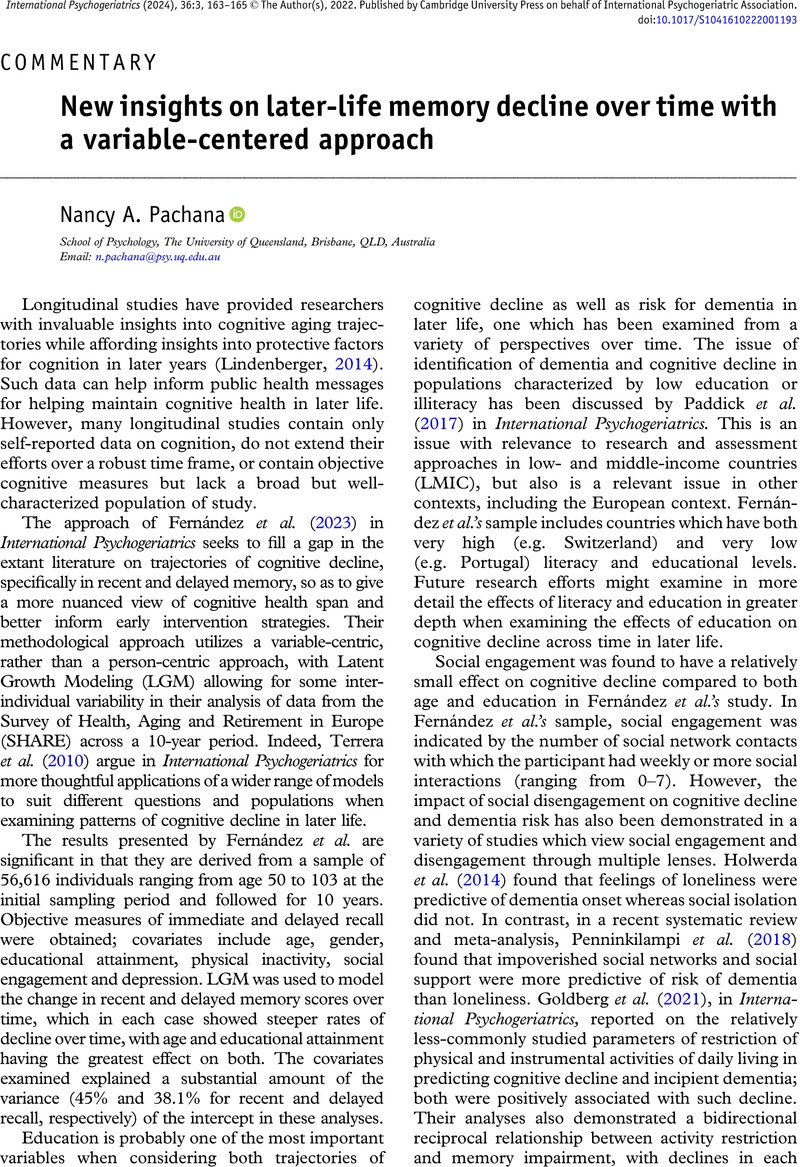No CrossRef data available.
Article contents
New insights on later-life memory decline over time with a variable-centered approach
Published online by Cambridge University Press: 21 December 2022
Abstract
An abstract is not available for this content so a preview has been provided. Please use the Get access link above for information on how to access this content.

- Type
- Commentary
- Information
- Copyright
- © The Author(s), 2022. Published by Cambridge University Press on behalf of International Psychogeriatric Association
References
Beattie, E., Pachana, N. A. and Franklin, S. J. (2010). Double jeopardy: comorbid anxiety and depression in late life. Research in Gerontological Nursing, 3, 209–220. https://doi.org/10.3928/19404921-20100528-99
CrossRefGoogle ScholarPubMed
Fernández, I., Tomás, J. and Bethmann, A. (2023). Latent trajectories of recent and delayed memory and its predictors: evidence from SHARE. International Psychogeriatrics.Google ScholarPubMed
Goldberg, T. E., Choi, J., Lee, S., Gurland, B. and Devanand, D. P. (2021). Effects of restriction of activities and social isolation on risk of dementia in the community. International Psychogeriatrics, 33, 1207–1215. https://doi.org/10.1017/S1041610221000776
CrossRefGoogle ScholarPubMed
Holwerda, T. J. et al. (2014). Feelings of loneliness, but not social isolation, predict dementia onset: results from the Amsterdam study of the elderly (AMSTEL). Journal of Neurology, Neurosurgery & Psychiatry, 85, 135–142. https://doi.org/10.1136/jnnp-2012-302755
CrossRefGoogle Scholar
Huang, L. Y. et al. (2020). Association of occupational factors and dementia or cognitive impairment: a systematic review and meta-analysis. Journal of Alzheimer’s Disease, 78, 217–227. https://doi.org/10.3233/JAD-200605
CrossRefGoogle ScholarPubMed
Hybels, C. F., Blazer, D. G., Eagle, D. E. and Proeschold-Bell, R. J. (2022). Age differences in trajectories of depressive, anxiety, and burnout symptoms in a population with a high likelihood of persistent occupational distress. International Psychogeriatrics, 34, 21–32. https://doi.org/10.1017/S1041610220001751
CrossRefGoogle Scholar
Leigh, L., Byles, J., Chojenta, C. and Pachana, N. A. (2016). Late life changes in mental health: a longitudinal study of 9683 women. Aging and Mental Health, 20, 1044–1054. https://doi.org/10.1080/13607863.2015.1060943
CrossRefGoogle ScholarPubMed
Lindenberger, U. (2014). Human cognitive aging: corriger la fortune? Science, 346, 572–578. https://doi.org/10.1126/science.1254403
CrossRefGoogle ScholarPubMed
Marchand, A., Blanc, M. E. and Beauregard, N. (2018). Do age and gender contribute to workers’ burnout symptoms? Occupational Medicine, 68, 405–411. https://doi.org/10.1093/occmed/kqy088
CrossRefGoogle ScholarPubMed
Marioni, R. E. et al. (2014). Cognitive lifestyle jointly predicts longitudinal cognitive decline and mortality risk. European Journal of Epidemiology, 29, 211–219. https://doi.org/10.1007/s10654-014-9881-8
CrossRefGoogle ScholarPubMed
Marioni, R. E., Valenzuela, M. J., van den Hout, A., Brayne, C., Matthews, F. E. and MRC Cognitive Function and Ageing Study. (2012). Active cognitive lifestyle is associated with positive cognitive health transitions and compression of morbidity from age sixty-five. PLoS One, 7, e50940. https://doi.org/10.1371/journal.pone.0050940
CrossRefGoogle ScholarPubMed
Olaya, B., Bobak, M., Haro, J. M. and Demakakos, P. (2017). Trajectories of verbal episodic memory in middle-aged and older adults: evidence from the English Longitudinal Study of Ageing. Journal of the American Geriatrics Society, 65, 1274–1281.CrossRefGoogle ScholarPubMed
Pachana, N. A. and Wahl, H. W. (2022). Healthy aging: current and future frameworks and developments. In: Asmundson, G. (Ed.), Reference Module in Neuroscience and Biobehavioral Psychology. Oxford, UK: Elsevier. https://doi.org/10.1016/B978-0-12-818697-8.00054-6
Google Scholar
Paddick, S. M., Gray, W. K., McGuire, J., Richardson, J., Dotchin, C. and Walker, R. W. (2017). Cognitive screening tools for identification of dementia in illiterate and low-educated older adults, a systematic review and meta-analysis. International Psychogeriatrics, 29, 897–929. https://doi.org/10.1017/S1041610216001976
CrossRefGoogle ScholarPubMed
Penninkilampi, R., Casey, A. N., Singh, M. F. and Brodaty, H. (2018). The association between social engagement, loneliness, and risk of dementia: a systematic review and meta-analysis. Journal of Alzheimers Disease, 66, 1619–1633. https://doi.org/10.3233/JAD-180439
CrossRefGoogle ScholarPubMed
Santabárbara, J., Lipnicki, D. M., Villagrasa, B., Lobo, E. and Lopez-Anton, R. (2019). Anxiety and risk of dementia: systematic review and meta-analysis of prospective cohort studies. Maturitas, 119, 14–20. https://doi.org/10.1016/j.maturitas.2018.10.014
CrossRefGoogle ScholarPubMed
Steptoe, A. et al. (2013). Cohort profile: the English longitudinal study of ageing. International Journal of Epidemiology, 42, 1640–1648. https://doi.org/10.1093/ije/dys168
CrossRefGoogle ScholarPubMed
Terrera, G. M., Brayne, C. and Matthews, F. (2010). One size fits all? Why we need more sophisticated analytical methods in the explanation of trajectories of cognition in older age and their potential risk factors. International Psychogeriatrics, 22, 291–299. https://doi.org/10.1017/S1041610209990937
CrossRefGoogle ScholarPubMed




